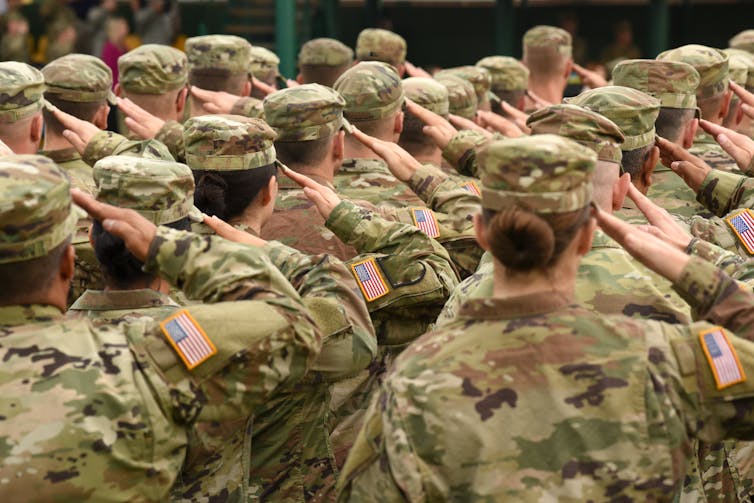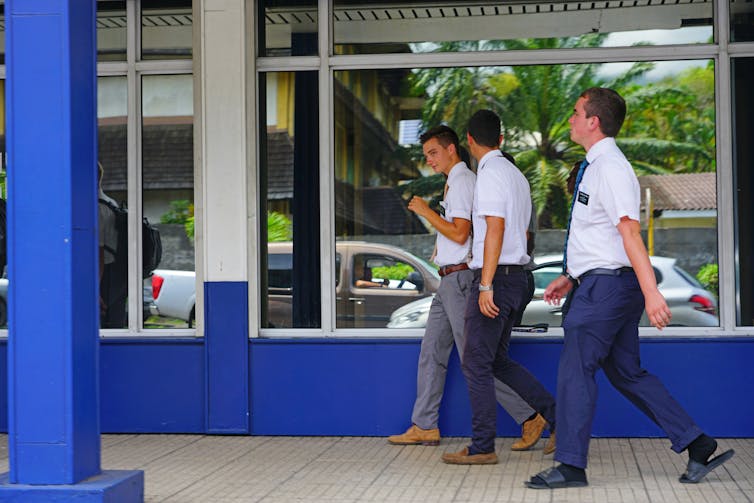How prisoners, soldiers and Mormon missionaries make the census more complicated
- Written by Rebecca Tippett, Director of Carolina Demography, University of North Carolina at Chapel Hill
The U.S. census is the most democratic and inclusive activity we do as a country.
For demographers like myself[1], this once-a-decade count serves as the backbone of virtually every product that we use to understand who Americans are, how they’ve changed and what this might mean for the future. The U.S. also uses the census counts to distribute political power and allocate funding for everything from highway spending to programs like Medicare and Head Start.
But not all groups are equally likely to be counted in the census.
Some, like college students[2] or people who own two homes, are more likely to be counted more than once. Others, like young children[3] or people who have recently moved, are less likely to be counted at all.
And then there those for whom getting counted is a little more complex, because where they live on Census Day – April 1, 2020 – is even less clear. There are three groups that have consistently posed problems to the U.S. census throughout history and continue to spark debate to this day: military members, Mormon missionaries and prisoners.
 In 2020, the Census Bureau will continue to count military personnel stationed overseas, but where they are counted will change.
Bumble Dee/Shutterstock.com[4]
In 2020, the Census Bureau will continue to count military personnel stationed overseas, but where they are counted will change.
Bumble Dee/Shutterstock.com[4]
Military members
Overseas military personnel have long been counted in the census, but they were not included in the apportionment population – the number the federal government uses to apportion 435 seats in the U.S. House of Representatives among the states – until the 1970 census.
Due to the scale of the Vietnam War and U.S. involvement in Southeast Asia, there was bipartisan congressional concern for the “unusually large numbers of military personnel [stationed] overseas on Census Day.”[5] U.S. military and federal civilian employees stationed abroad, and their dependents living with them, were counted and allocated back to their home states beginning in 1970.
Although this group was left out of the 1980 census, due to no official legal requirement and no demand, U.S. military and federal civilian employees have been counted and included in the apportionment population in every census since 1990.
For the purposes of congressional apportionment, these individuals are allocated to their state of residence. That means that a person from North Carolina who might be serving abroad in Iraq will count as a resident of North Carolina.
Because the 1990 census included military personnel stationed abroad, one seat in the U.S. House of Representatives shifted from Massachusetts to Washington state. Massachusetts challenged the Census Bureau’s decision to count military personnel abroad, arguing that it created an inequality in the counting of state populations.
The Supreme Court disagreed with Massachusetts. In Franklin v. Massachusetts[6] in 1992, the court found that the enumeration of overseas military personnel was “consistent with constitutional language and goal of equal representation.” They found that the Census Bureau’s decision on where to count individuals was consistent with their standard of “usual residence,” which reflects where people live and sleep most of the time.
In 2020, the Census Bureau will continue to count military personnel stationed overseas, but where they are counted will change.
Traditionally, military personnel were counted at their “home of record” – their permanent address according to the military.
But, in 2020, military personnel who are temporarily deployed abroad will be counted at their home base address, not their home of record. For example, an Army soldier stationed at Fort Bragg in Fayetteville, North Carolina, who is temporarily deployed abroad, would be counted at their Fayetteville address.
This could have a big impact in communities and states with a large military presence[7], such as North Carolina, Texas and California, who could stand to receive more federal funding.
Mormon missionaries
The Census Bureau does not count other Americans abroad.
This decision has a large impact on Utah. Utah has a significant overseas population: In 2000, there were more than 11,000 Mormon missionaries from Utah living abroad, more than three times the state’s overseas military and federal employee population.
Had these missionaries been included in the 2000 census count, Utah would have gotten a fourth seat in the House of Representatives. Instead, the House seat went to North Carolina, which had 18,360 overseas military and federal personnel counted in the census.
Much like Massachusetts after the 1990 census, Utah sued after the 2000 census[8], claiming that either Mormon missionaries should be counted or no American living abroad should be counted.
The district court disagreed. They found that Utah’s argument was not fundamentally different from the argument Massachusetts had made a decade earlier. Moreover, they found that including only Mormon missionaries in addition to federal employees “would overwhelmingly favor Utah vis-a-vis all forty-nine other states.” In other words, all states can benefit from the Bureau counting federal overseas employees, but only Utah would benefit from the inclusion of Mormon missionaries. The Supreme Court declined to hear the case on appeal.
 Young Mormon missionary men walking in Papeete, Tahiti.
EQRoy/Shutterstock.com[9]
Young Mormon missionary men walking in Papeete, Tahiti.
EQRoy/Shutterstock.com[9]
Prisoners
Since the first U.S. census was conducted in 1790, prisoners have been counted as residents of their correctional facility, not at their home address[10].
This sparked nearly 78,000 comments to the Census Bureau when they published a document in the Federal Register in 2018 asking for public input on census residence criteria[11]. Virtually all comments suggested that prisoners should be counted at their home address or where they lived before being incarcerated.
In a summary of the comments, the Census Bureau noted, “Almost all commenters either directly suggested, or alluded to the view, that counting prisoners at the prison inflates the political power of the area where the prison is located, and deflates the political power in the prisoners’ home communities.”
Prior to the 1970s, the size of the incarcerated population was small enough that it did not have a clear impact on redistricting. Today, the size of the prison population, at 2.2 million people, can distort redistricting processes by creating voting districts made up primarily of incarcerated populations. Or, it could play a role in a community receiving increased grant money based on census counts. In other words, a county with a large prison would receive more votes and more federal funding.
Some commenters on the Census Bureau’s federal register notice argue that these impacts are unfair, as in most states, prisoners cannot vote[12].
To address some concerns about “prison gerrymandering,” some states have passed laws that require relocating prisoners to their last known home addresses for redistricting purposes[13].
Communities only have one shot to count all of their residents. If a community is undercounted, or if the rules governing who counts and where they count change, it can have lasting implications on representation and federal funding for the next decade.
[Insight, in your inbox each day. You can get it with The Conversation’s email newsletter[14].]
References
- ^ demographers like myself (www.cpc.unc.edu)
- ^ college students (www.ncdemography.org)
- ^ young children (www.census.gov)
- ^ Bumble Dee/Shutterstock.com (www.shutterstock.com)
- ^ “unusually large numbers of military personnel [stationed] overseas on Census Day.” (www.census.gov)
- ^ Franklin v. Massachusetts (www.law.cornell.edu)
- ^ in communities and states with a large military presence (www.rollcall.com)
- ^ sued after the 2000 census (law.justia.com)
- ^ EQRoy/Shutterstock.com (www.shutterstock.com)
- ^ as residents of their correctional facility, not at their home address (www.npr.org)
- ^ asking for public input on census residence criteria (www.federalregister.gov)
- ^ prisoners cannot vote (www.motherjones.com)
- ^ require relocating prisoners to their last known home addresses for redistricting purposes (www.prisonersofthecensus.org)
- ^ You can get it with The Conversation’s email newsletter (theconversation.com)
Authors: Rebecca Tippett, Director of Carolina Demography, University of North Carolina at Chapel Hill

